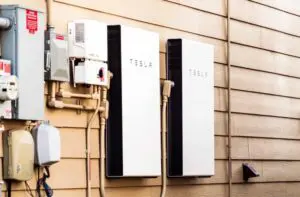Consumer rage over energy tariffs and pricing has energy executives on their toes, with two from Australia’s biggest retailers saying households and their energy devices are now the frontline of bringing prices down.
Coordinating rooftop solar, home batteries and electric vehicles, as well as sorting out Australia’s weighty burden of regulations, will bring prices down, says AGL chief Damien Nicks.
“CER [consumer energy resources] is the missing ingredient to help bring prices down and share in the value of the energy transition,” he told an industry forum today, in a speech heavily focused on consumers.
“Ensuring effective coordination and integration of CER through virtual power plants to reduce costs for customers will be an outcome, among others, that we are looking for.”
EnergyAustralia chief Mark Collette was also determined that home batteries in particular must be connected to the grid, and also warned of higher costs from network build outs if consumers don’t hand over control.
“Every battery must count for the grid. At Energy Australia, we envision that every battery should provide network and wholesale services. That’s the only way we will minimise what needs to be built in the grid,” he says.
“If we grow maximum demand and don’t grow utilisation, builds will go up. Smart software that moves energy usage coupled with smart battery investments can fundamentally change the way these work.
The comments by Nicks and Collette come in the wake of consumer astonishment at the way energy retailers across the country are jacking up electricity rates to meet much higher default market offers, as revealed by Renew Economy editor Giles Parkinson who received a 25 per cent price hike from his retailer, “because it can”.
Federal energy minister Chris Bowen admitted on Wednesday that current regulatory arrangements are failing to protect consumers, who he says are being “gouged” by energy retailers. He is flagging chances to the setting of the Default Market Offer, in an attempt to force more competition in the market.
Nicks promised AGL does not, in most instances, change customer tariffs after smart meters are installed, and aims to keep customers on their current tariff rather than hiking to meet higher default market offers – two issues that have caught households out in the past.
He said demand tariffs, opaque tariffs that charge customers much more based on their highest energy use period during a month which have also led to widespread outrage, were counterproductive.
Cost-reflective tariffs such as Time of Use were better options as they reward shifting energy use to -offpeak periods, rather than punishing the necessary use of power during peak times.
CER must be grid connected
Nicks was firm on the need to drive further electrification at a household level and pull those devices into orchestrated systems, such as virtual power plants (VPP).
Doing so will avoid an estimated $4 billion for extra large-scale battery storage by 2050, and orchestration is widely seen as necessary to create a cohesive energy system that can make the best use of behind the meter devices, he says.
EnergyAustralia chief Mark Collette described the way that smart meters might work.
“When your oven turns on for dinner, smart software can briefly interrupt your air conditioning or pause your EV charging,” he said.
“For those 20 or 30 minutes, the oven gets priority. Your comfort isn’t compromised, and we avoid the need to build more network, because peak demand doesn’t go up. Scale this across 1000s of homes and businesses, and suddenly our existing grid can handle much more demand and usage without expensive upgrades.”
Nicks says AGL has been growing the company’s VPP to support renewables, improve grid stability, and drive down electricity prices, and is also paying for rooftop solar systems for low income households to allow more people to share in the savings.
But both executives’ speeches to the Australia Energy Week forum were short on mentions of social licence, with both only mentioning it once.
To date, VPPs have failed to win over consumers because they have not put households first, the owners of the devices they seek to control.
And any social licence for retailers to control home devices is being eroded by rising prices, which consumers conflate with renewable energy rather than price gouging – as alleged late last year by The Australia Institute – or coal power plant outages and costly gas.
Generators, retailers eye consumer devices
The onus to bring down prices is now squarely on consumers and their energy resources.
Collette believes that harnessing rooftop solar and batteries can bring wholesale power prices back down to $50 a megawatt hour (MWh).
“Let’s examine what’s actually working in our transition from that perspective, because that’s where we’ll find the path to cheaper energy. Solar and batteries are our superstars,” he told the forum.
“[In regions with high solar irradiance] Queensland, Western Australia, the Northern Territory, we could see $50 energy, again, with a mix of direct and stored solar. This could be Australia’s path back to challenge countries like Canada on energy costs. Can we get there?… Absolutely.
“It means designing around Australia’s comparative advantages in energy for customers in southern states like me, where winter sun is not enough to power our homes year round, the solution might be greater connection to the north, or making greater use of the connection to the north.
” All-year sun and batteries in Queensland is just going to be fundamentally cheaper than Victoria’s two thirds a year. Of course, I’m not saying stop developing anything other than northern sun. Wind in the southern states is important.”
And yet retailers are likely to be the best placed organisations to help households engage with orchestration if they wish, and help them through the challenges, Nicks says.
“Retailers will also continue to play a vital role in managing wholesale risks for customers and in developing products that can help them unlock the value of CER. The opportunity to get industry regulation right, so that it benefits every customer, is enormous,” he says.







